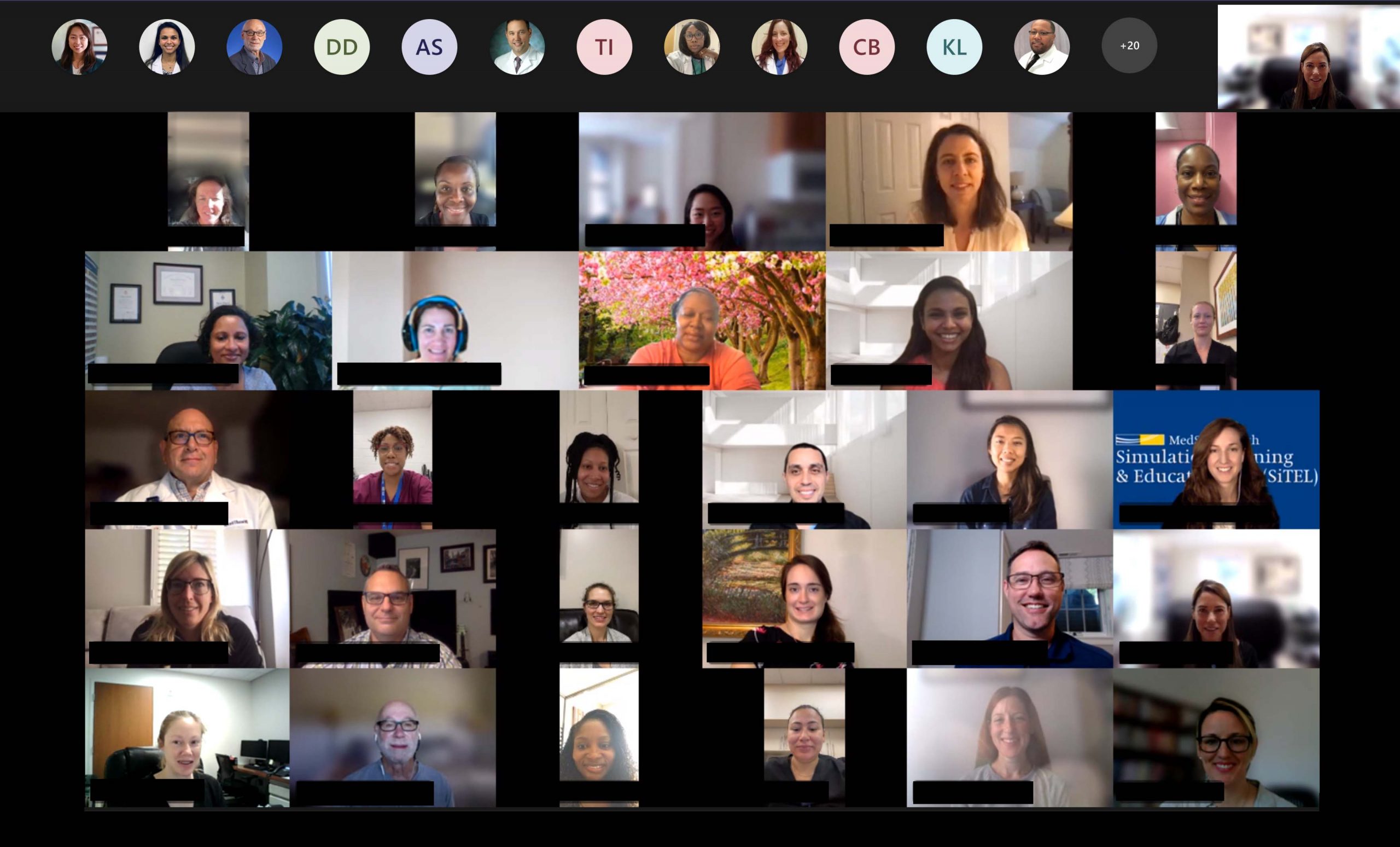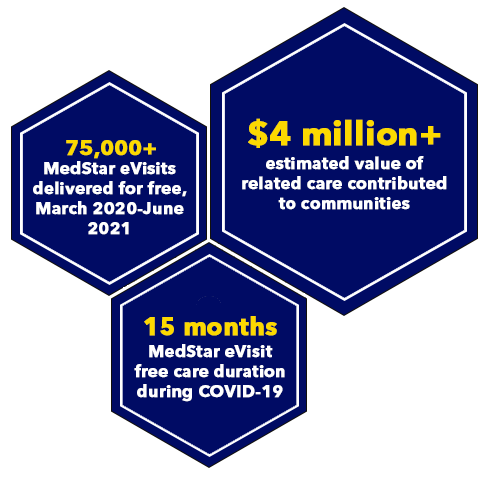MedStar eVisit Zip Codes Served, March 2020-June 2021 (Click image to enlarge)
Background
Since 2015, MedStar Health has offered patient-initiated, on-demand video access to medical providers 24/7/365 through MedStar eVisit, supporting all ages with minor health issues that do not require in-person evaluation or testing. Examples of conditions we have treated through MedStar eVisit include cold or mild flu symptoms, allergies, pink eye, rash, minor cut, known urinary tract infection or yeast infection, gout flare-up, and, once the pandemic struck—COVID-19 screening and testing guidance.
While MedStar eVisit services were offered for a fee prior to the COVID-19 public health emergency (PHE), the pandemic presented unique factors that prompted MedStar Health to consider temporarily waiving the MedStar eVisit fee during the height of the crisis:
-
At the onset of the COVID-19 pandemic in our area, many people were not familiar with getting care through telehealth, and insurers were in the process of determining if and how certain coverage would evolve due to the PHE.
-
Our urgent care locations and emergency departments needed to have as much capacity as possible to treat the most critical needs in-person.
-
In March and April 2020, COVID-19 test availability was not as prevalent. As a result, it was most appropriate for most patients to stay home and quarantine and to understand what they and their loved ones needed to know and do during this time.
Idea
To best respond to this situation and help patients access care during this unprecedented time, MedStar Health began temporarily waiving the fee for our MedStar eVisit service in March 2020 during the height of the crisis. We believed this was one of the ways we were uniquely positioned to help manage the threat of COVID-19 in the communities we serve.During this period, many patients using MedStar eVisit received the care they needed at the time solely through this telehealth session. However, the MedStar eVisit team also assisted many patients in finding the right next step in their care. Providers also referred many patients to a COVID-19 testing site, primary care, or a specialist, or recommended and facilitated a care transition to urgent care or the emergency department.
As the situation evolved, we adapted the care we delivered to address the latest COVID-19 concerns and conditions:
-
In the beginning, providers primarily offered information and reassurance, especially when it came to recommendations about quarantine and other safe practices.
-
As testing tents became more available, providers began referring patients with mild symptoms or exposure concerns to them. Or, if in-person assessment or intervention was appropriate, patients were assisted in a transition to an urgent care location or the emergency department.
-
As time progressed, quarantine-related questions increased, especially regarding how to keep other family members safe during this time and about how to safely return to work once quarantines were complete. Meanwhile, questions about COVID-19 testing and where to get it decreased as testing became more widespread.
-
By the winter of 2020, many MedStar eVisit patients with COVID-19 concerns were aware that they had been exposed or were sick. Many questions again focused on how long to quarantine and when it was safe to return to work.
-
As COVID-19 vaccines became available, the MedStar eVisit team prepared to address general questions about them or any related side effects patients may experience, but providers did not receive many related inquiries during MedStar eVisit sessions.
-
By spring and summer of 2021, many MedStar eVisit patients had used the service previously and the percentage of care pertaining to COVID-19 continued to decline. Meanwhile, acuity, complexity, and diversity of other conditions providers treated via MedStar eVisit were going up and requiring more referrals to in-person care compared with the pre-pandemic period. Many MedStar eVisit patients were inquiring about whether they needed in-person care, and if the urgency of their situation was most appropriate for scheduled primary or specialty care, urgent care, or the emergency department.
MedStar eVisit volume skyrocketed because of COVID-19 in March 2020. The seven visit per day average for the service pre-COVID climbed rapidly to more than 500 visits a day at peak just days after the pandemic response began. This prompted MedStar eVisit to adapt from treating patients primarily through providers who were affiliated with its telehealth technology platform partner Amwell, to treating patients almost solely through MedStar Health providers. As a result, many MedStar eVisit providers treated thousands of patients via the platform from March 2020 through June 2021. Read more here about how MedStar eVisit was further scaled and customized during the pandemic.
Impact
From March 2020 through June 2021, MedStar Health provided more than 75,000 MedStar eVisits at no cost to patients. This represents a more than $4 million estimated contribution of free MedStar eVisit care to our communities.
At peak, about 60% of MedStar eVisit encounters pertained to COVID-19. Through the initial surges, about half of all visits related to COVID-19, and this was down to about a quarter of concerns by summer of 2021.
About 25% of patients were referred to a COVID-19 testing tent at peak, roughly 15% to an in-person urgent care visit, and around 4% to an emergency department (including non-MedStar Health locations when appropriate for a patient’s situation).
Importantly, both quantitative and qualitative reports have shown that offering MedStar eVisit for free during the height of our COVID-19 response was an important tool for reaching vulnerable populations. We treated many people who reported they did not have insurance or an ability to pay the traditional fee at that time; were unwilling or unable to go to in-person care; or who faced other challenges. An analysis of MedStar eVisit care by zip code further suggests the service reached low-income neighborhoods where people may have limited access to traditional in-person care, including areas around the heart of Baltimore City and Wards 7 and 8 in Washington, D.C. Additionally, the ability to involve interpreters in MedStar eVisit consultations within minutes also made a difference, and the support we offer with American Sign Language needs is especially unique among on-demand telehealth services.
By late spring of 2021, cases of COVID-19 were on the steep decline and a growing number of people were vaccinated for COVID-19. As a result, at the start of our fiscal year on July 1, 2021, MedStar Health began to charge for MedStar eVisit services again. By this time, most insurance providers were also covering telehealth visits and we could verify that for many plans at the time of service. For patients who choose to pay for services directly, the cost is usually $79.
As the public health emergency—and MedStar Health's related care to the community—continue, we encourage those who are concerned about the ability to pay for necessary care via MedStar eVisit to initiate a visit to receive instructions about how to speak with someone about these financial concerns at no charge in an effort to ensure we are still serving our most vulnerable populations. We can also utilize MedStar eVisit interpretation services during these conversations if needed. MedStar eVisit providers follow corporate policy for these needs-based assessments to determine how to manage each financial concern on a case-by-case basis.
Looking ahead
Ethan Booker, MD, the medical director of MedStar eVisit and the MedStar Telehealth Innovation Center, says the evolution of MedStar eVisit as a result of COVID-19 underscores important points about telehealth more broadly.
“Telehealth encounters should not solely be thought of as the destination for care,” he said. “While evaluation and management of conditions is a critical component of the telehealth services we offer, telehealth can also support patients in navigating and accessing care and testing more broadly. Telehealth often opens the door to helping treat people holistically.”
Providers report that practicing through MedStar eVisit supported their own well-being during the pandemic. They also faced unique situations and stressors, especially during a time when so many people grappled with illnesses in their families or remote school. Supporting patients through MedStar eVisit also gave them additional flexibility to care for themselves and others close to them personally too. Looking to the future, offering opportunities for our providers to practice on-demand telehealth can help MedStar Health advance goals related to provider well-being, talent retention, and even equity, inclusion, and diversity.
“Our MedStar Health providers treating patients through MedStar eVisit have become highly skilled at delivering care via on-demand telehealth,” Dr. Booker added. “We want our communities to know about the increased level of high-quality—often complex—care we are providing through this tool, which will last beyond the pandemic. Continued excellence and innovation in on-demand telehealth are essential to the future of care delivery.”
Resources
Websites
News
-
PR Newswire, Amwell Recognizes Leading Healthcare Organizations for Achieving Telehealth Excellence and Advancing Digital Care Delivery (April 29, 2021)
-
Becker’s Hospital Review, Celebrating healthcare organizations who made a considerable impact in their communities through virtual care (May 7, 2021)
Patient testimonial
“This was shockingly(!!) easy to setup and do. I was awake and stressed trying to figure out corona testing. This was the ONE place that made it simple. I was in queue to see a physician before I even fully realized it. The most critical parts were quickly seeing a doctor and having the fees temporarily waived to meet the needs of people. This invaluable, personal kind of care is what we need and truly looks after the community.”
Provider perspectives
“It was a privilege to participate in a program of pure and free medical care. Personally, MedStar eVisit enabled me to provide medical care even when I was not able to do so in an urgent care facility. It allowed me to help patients directly and my medical colleagues indirectly.
Through MedStar eVisit, we also helped patients avoid unnecessary emergency department and urgent care visits. We were able to provide links to primary care providers or appropriate specialists for ongoing follow up care. We supported expedited COVID-19 testing, referrals for monoclonal antibody treatment, and the provision of up-to-date and accurate information and advice to patients coping with the pandemic.
MedStar eVisit also gave me a window into patients’ living conditions. I clearly saw the impact of inequalities that exist socially and economically on the health status of the communities we serve. For example, a mutigenerational family living together in a small space faced an inability for the COVID-positive among them to quarantine from the others. Other patients struggled with how to quarantine yet earn income they rely upon. As MedStar eVisit returns to receiving payment for services rendered to the insured or those able to pay, it makes me proud MedStar Health will still explore possibilities to help those who are unable to afford health care.”
- Ron Greger, MD, MedStar eVisit provider
Page first published: 8/17/21
Summary
MedStar Health waived the fee for our MedStar eVisit service during the height of our pandemic response.
Teams
MedStar Telehealth Innovation Center in partnership with MedStar Medical Group and MedStar Ambulatory Services
Status
Active











